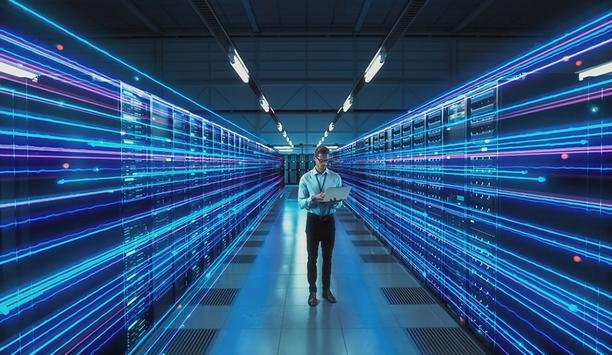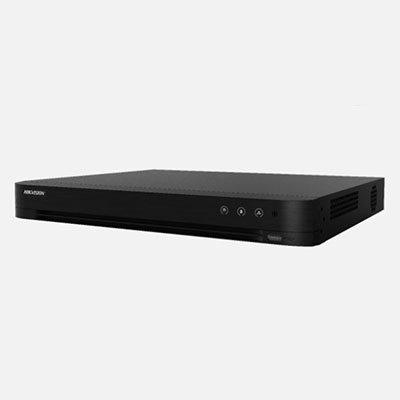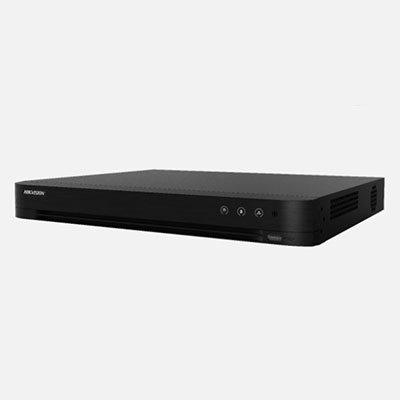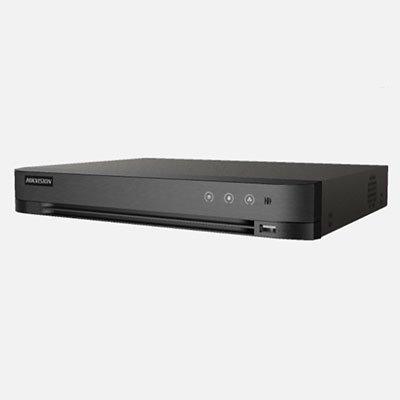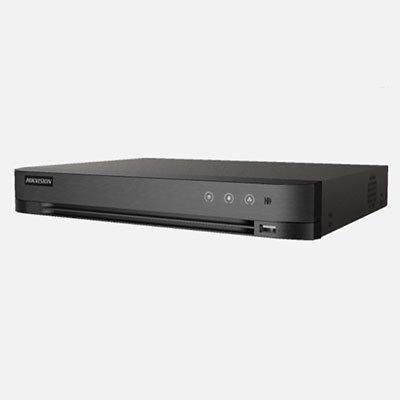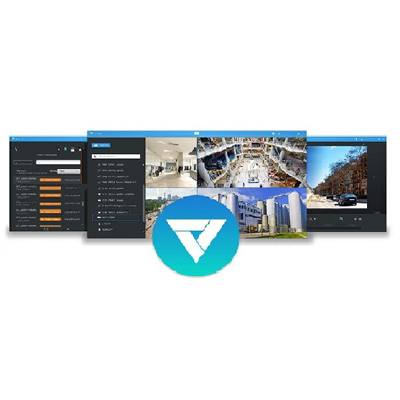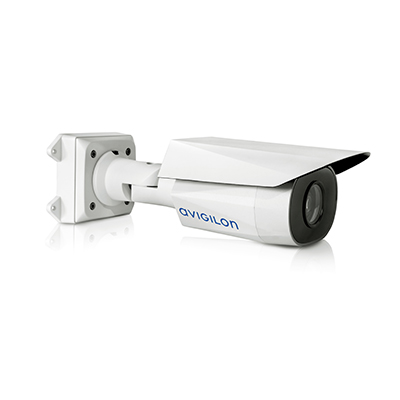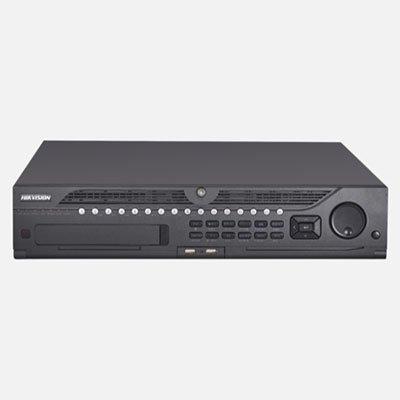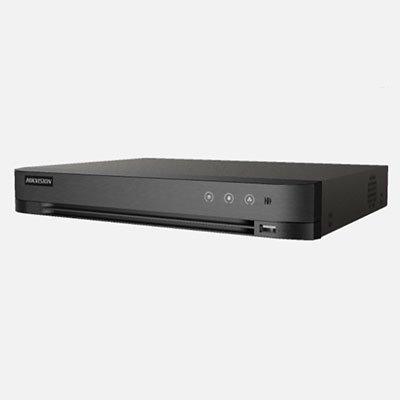Video analytics

White papers

Selecting the right network video recorder (NVR) for any vertical market
Download
How intelligent video is transforming banking and financial institutions
Download
The real cost of an outdated Video Security System
Download
Understanding the IT needs of video surveillance
Download
AI in security solution
Download
VSS - Top 4 questions to get you started
Download
3 ways AI can improve safety and reduce compliance costs
Download
Levelling up with campus safety
Download
IoT connectivity
Download
2023 trends in video surveillance
Download
5 must-haves for seamless VMS connectivity
Download
The future of healthcare security is connectivity
Download
Smart surveillance in the workplace
Download
Improving city mobility using connected video technology
Download
The benefits of Edge AI + Cloud for security systems
Download

News
Bromsgrove-based security and monitoring company, Ecl-ips, is celebrating its win at the North Worcestershire Business Awards 2024. Best use of Technology Ecl-ips was a winner in the ‘Best use of Technology’ award category at the event at Hogarths Stone Manor near Kidderminster. Ecl-ips beat two other finalists: Redditch-based TSR Electrical Group and StarkEV, an electrical vehicle charging point installer to win. The security installer was among the 30 local businesses that were shortlisted for an award. HALO Smart Sensor The entry from Ecl-ips centred on the advanced technology that is provided by its vape detector offering, the HALO Smart Sensor manufactured by IPVideo in the USA. Ecl-ips was one of the first companies in the UK to identify the potential of the technology that provides real-time alerts of vaping as well as providing indoor air quality monitoring. Addressing the vaping problem This smart sensor has supported schools in the UK to tackle the problem of young people who are vaping With all its solutions Ecl-ips aims to find the best partners to help meet the needs of its clients. This smart sensor has supported schools in the UK to tackle the problem of the rising numbers of young people who are vaping. Schools are finding that students are disrupting lessons by asking to go to the toilet and creating an intimidating atmosphere in the school toilets because more students are gathering in them to vape. Vape detector When combined with strengthened behaviour policies and the use of CCTV outside the toilets to confirm the identities of students, the vape detector has proved to be very effective at improving pupil behaviour and reducing vaping at school. Ecl-ips customer, Charlotte Slattery Deputy Head Teacher at St Joseph’s College in Stoke-on-Trent, said, “I had dithered about it for over 12 months due to the cost but it has been transformational for us. We started with only 2 devices in our worst areas and have now ordered another 5 to go into more toilets.” North Worcestershire Business Awards The North Worcestershire Business Awards were judged by an independent panel that said the finalists reflect “an impressive range of diverse businesses, all showcasing their commitment to growth, sustainability and adding extra value for customers.” In their sixth year, the awards are organised by North Worcestershire Business Leaders (NWBL) and the local authorities in North Worcestershire in partnership with Hogarths Stone Manor.
IDEMIA Public Security North America, a pioneering provider of secure and trusted biometric-based solutions, has announced a partnership with Kudelski IoT, a division of the Kudelski Group and a global pioneer in digital security. This collaboration aims to enhance fraud prevention and regulatory compliance in the automotive retail industry by leveraging IDEMIA’s Identity and Verification (ID&V) technology. IDEMIA’s ID&V solution Kudelski IoT will deploy IDEMIA’s ID&V solution for document authentication and biometric matching Through this partnership, Kudelski IoT will deploy IDEMIA’s ID&V solution for document authentication and biometric matching across its large base of U.S. automotive dealership customers. The solution will be used to validate driver’s licences and verify customer identities during critical processes such as test drives, financing applications, and vehicle purchases. This initiative is designed to reduce the growing threat of identity scams and fraud in vehicle transactions, with a projected annual volume of more than 200,000 identity verifications. Advanced identity verification solutions "We’re excited to partner with IDEMIA to bring advanced identity verification solutions to the automotive market to complement our RecovR lot management and theft recovery solution. By integrating IDEMIA’s biometric and document authentication technology into our offering, we can provide our more than 1,000 customers with enhanced security and fraud prevention tools that meet the specific needs of vehicle transactions." "This collaboration strengthens Kudelski IoT’s commitment to delivering cutting-edge, asset management and protection solutions to the industry," said Patrick Hauert, SVP of Kudelski IoT’s Asset Tracking product unit. Advanced document authentication IDEMIA’s ID&V key is planned to ensure people are who they claim to be, utilising copy authentication IDEMIA’s ID&V solution is designed to ensure that individuals are who they claim to be, utilising advanced document authentication with features such as digital tampering detection, document identification, and font anomaly analysis. The solution complies with the highest security standards, having been approved by the Kantara Initiative for compliance with NIST SP 800-63 rev. 3 Component Service at Identity Assurance Level 2 (IAL2). Automotive retail sector "We are proud to work with Kudelski IoT to bring secure, trusted identity verification to the automotive retail sector. Our ID&V technology will provide Kudelski IoT with the ability to protect their customers from fraud, ensuring that every transaction is as secure as possible." "We are eager to see the positive impact this solution will have on the industry," said Donnie Scott, CEO of IDEMIA Public Security North America.
Siemens and Genea recently announced a second collaborative effort to provide security professionals and facility managers with improved security using the cloud. The security solution allows teams to leverage their existing technology, like security cameras, door readers, controllers and more, and manage it all from a modern dashboard, anytime, anywhere. Siemens’ security customers Through Genea’s customisable, cloud-based, open API platform, Siemens’ security customers can now integrate various current building systems or applications, such as visitor management, Apple Wallet, video management or identity management. Genea makes it possible to assign and distribute NFC and Bluetooth mobile credentials directly to users’ smartphones. As an added convenience, credentials can also be stored in Apple and Google Wallet, for easier accessibility. Integrated systems Customers can transition to the cloud without paying to replace their entire hardware system Since Genea runs on non-proprietary door readers and Mercury controllers, customers can transition to the cloud without paying to replace their entire hardware system. This commitment to open standards helps guarantee that the integrated systems will provide exceptional performance while safeguarding customers' investments in security infrastructure. Genea's advanced platform "Teaming up with Genea underscores our dedication to expanding the Siemens Connect Ecosystem program by delivering top-tier security solutions using non-proprietary Mercury hardware," said Rich Reidy, US Security Segment Head of the Buildings business at Siemens Smart Infrastructure USA. "As a trusted and proven pioneer in the industry, Genea's advanced platform and flexible technology align perfectly with our goal of offering cutting-edge, adaptable solutions for the future.” Flexible security solution Genea and Siemens first collaborated 5 years ago with the goal of enhancing real estate operations Genea and Siemens first collaborated five years ago with the goal of enhancing commercial real estate operations. With Genea On-Demand HVAC and Genea Submeter Billing, property teams were able to drive significant energy savings and operational efficiencies. This latest joint effort gives Siemens’ customers a flexible security solution that remains adaptable to the evolving needs of enterprises, universities, schools, healthcare facilities, commercial real estate properties and other markets. Transition to cloud-based security "We are excited to once again collaborate with Siemens, a company that shares our dedication to innovation and excellence," said Eric Moe, Senior Vice President of Sales, Security at Genea. "This latest endeavour that targets the physical security market allows us to pair with an industry pioneer and help more organisations transition to cloud-based security.”
iDenfy, a pioneer in identity verification and compliance solutions, has announced its new partnership with Portugal Residency Advisors, a consulting firm specialising in comprehensive relocation and investment services in Portugal. The partnership aims to automate the onboarding process and strengthen security measure regulations for the new clients. Identity verification solutions The challenges related to identity fraud and regulatory compliance have increased as well As digital and cross-border transactions continue to grow. The challenges related to identity fraud and regulatory compliance have increased as well. According to Statista, in 2022, global financial fraud losses reached an estimated $41 billion, highlighting the need for robust, automated identity verification solutions. This collaboration allows Portugal Residency Advisors to verify the legitimacy of their global client list swiftly and securely while reducing compliance risks and manual verification work. Relocation and investment process Portugal Residency Advisors has been a trusted partner for individuals, families, and businesses looking for information about residency, property acquisition, tax compliance, and relocation in Portugal. The firm’s unique value lies in its ability to offer peace of mind throughout the relocation and investment process, tailored to the client’s individual needs as well as doing business. Client verification standards The firm is not only using an identity verification key to onboard singular users but also AML For this reason, the company is not only using an identity verification solution to onboard singular users but also anti-money laundering services (AML), together with near-field communication (NFC) verification, to exploit the latest features and optimise users' onboarding journey. As the company expands its operations to serve a diverse, international customer base, maintaining rigorous client verification standards is critical. Advanced biometric algorithm iDenfy’s identity verification system, already trusted globally, is equipped to recognise over 3,000 types of identity documents across 200 countries and territories. Advanced biometric and face recognition algorithms ensure that the analysed faces are real, helping to prevent the use of pictures of faces, 3D masks, and other fake fraudster tricks during the identity verification process. iDenfy’s advanced AML Screening Software iDenfy’s advanced AML Screening and Ongoing Monitoring Software offers a powerful solution Furthermore, iDenfy’s advanced AML Screening and Ongoing Monitoring Software offers a powerful solution to help Portugal Residency Advisors streamline their onboarding process and enhance compliance measures. By seamlessly scanning users against international sanctions, politically exposed persons, and law enforcement watchlists, iDenfy enables the detection and blocking of potential fraudsters or illegal applicants seeking residency permits. Advanced AML filtering algorithm Additionally, with an advanced AML filtering algorithm, the platform distinguishes genuine threats from adverse media, reducing recognition and getting most of the information about the individual. The software connects global enforcement authorities such as Interpol, Europol, and the FBI and empowers Portugal Residency Advisors to safeguard national security while delivering a smooth onboarding experience for valid applicants. NFC chip data iDenfy offers NFC verification, held by eIDAS, which brings unparalleled convenience Alongside its advanced AML screening and ongoing monitoring software, iDenfy offers NFC verification, regulated by electronic identification, authentication, and trust services (eIDAS), which brings unparalleled convenience and security, providing a seamless and stress-free experience for applicants. With instant NFC chip data reading and identity verification completed in as little as 40 seconds, the feature ensures a faster and more user-friendly process. Cross-checking security certificates Also, Public Key Infrastructure (PKI) guarantees spoof-proof verification by cross-checking security certificates with global authorities, further enhancing reliability. The function is fully compatible with Android and iOS devices, “We chose iDenfy because their solution stands out for its reliability and simplicity in onboarding, making it an ideal partner as we prioritise our clients' experience. iDenfy’s technology helps us ensure full compliance while maintaining trust and efficiency in our processes,” said Pedro Branco, Managing Director of Portugal Residency Advisors. Advanced identity verification solutions PKI guarantees spoof-proof verification by cross-checking security certificates “We’re excited to work with Portugal Residency Advisors in their mission to simplify relocation and investment processes for their clients." "Our advanced identity verification and compliance solutions will empower them to expand confidently while protecting against fraudulent activities,” said Domantas Ciulde, the CEO of iDenfy. Integrating iDenfy’s technologies By integrating iDenfy’s technologies, Portugal Residency Advisors will enhance their ability to conduct due diligence, meeting both internal security standards and global compliance requirements. This partnership marks a step forward in providing a safer, more efficient onboarding process that builds international trust for clients worldwide.
Expert commentary
The artificial intelligence revolution in physical security has arrived, transforming how we protect people, assets, and infrastructure. From smart buildings that automatically adjust access protocols based on real-time threat assessments to healthcare facilities using AI-enhanced video analytics for patient safety, these technologies are reshaping the industry landscape. But with this transformation comes a new era of regulatory oversight that security professionals must navigate carefully. Convergence of AI The convergence of powerful AI capabilities with traditional security systems has created unprecedented opportunities for enhanced protections while simultaneously raising important questions about privacy, transparency, and responsible deployment. As these technologies become more sophisticated, security professionals face the dual challenge of maximising their potential while ensuring compliance with evolving regulatory frameworks. The current state of AI in security systems By combining multiple data streams, AI creates a more comprehensive and intelligent security ecosystem Today's AI-driven security solutions extend far beyond traditional security capabilities. Modern systems can understand complex human behaviours, analyse crowd patterns in transportation hubs, detect early signs of trouble in retail environments, and even predict potential security breaches before they occur. By combining multiple data streams — video feeds, access control systems, audio detection, and various sensors — AI creates a more comprehensive and intelligent security ecosystem. Industrial applications The impact is particularly evident in integrated security operations. In healthcare settings, AI systems can simultaneously monitor patient safety, manage access control, and detect unauthorised entries, all while maintaining strict privacy protocols. In education environments, these technologies help safeguard campuses by identifying unusual behaviour patterns while respecting student privacy rights. Retail operations benefit from AI's ability to not only detect potential theft but also analyse customer flow patterns and identify operational inefficiencies. The technology's capabilities continue to expand through: Advanced anomaly detection that establishes normal activity patterns and flags deviations. Predictive analytics that forecast potential security risks before incidents occur. Natural language interfaces that allow security teams to query video data using voice or text commands. Multimodal analysis combining data from thermal cameras, LIDAR, IoT sensors, and other sources. Integration of multiple data sources Security systems are evolving into predictive platforms that can anticipate and prevent incidents These innovations represent just the beginning of AI's potential impact on security applications. As algorithms become more sophisticated and computing power increases, security systems are evolving into predictive platforms that can anticipate and prevent incidents rather than simply respond to them. The integration of multiple data sources allows for a more nuanced understanding of security situations, enabling more precise and effective responses to potential threats. Emerging regulatory frameworks The rapid advancement of AI capabilities has prompted governments worldwide to develop comprehensive regulatory frameworks. The European Union has taken the lead with its AI Act, categorising AI systems based on their potential risks and establishing strict guidelines for high-risk applications. Focus on safe, secure AI The United States is following suit, with recent executive orders focusing on safe, secure, and trustworthy AI development. These initiatives reflect growing global awareness of the need to balance technological advancement with ethical considerations and human rights protection. These regulations are reshaping how security technology providers approach development and implementation. Responsibility-by-design approach Companies must consider the entire lifecycle of their AI solutions, from initial development The focus has shifted toward a "responsibility-by-design" approach, where privacy protection, data security, and ethical considerations are built into systems from the ground up. This includes robust testing protocols, responsible data practices, and continuous monitoring of AI systems post-deployment. Companies must consider the entire lifecycle of their AI solutions, from initial development through deployment and ongoing operation. Transparency, accountability For security professionals, this regulatory evolution means adapting to new requirements around transparency, accountability, and human oversight. Security teams must document how AI systems make decisions, implement safeguards against bias, and ensure human operators maintain final authority over critical security decisions. The regulations also emphasise the importance of data protection, requiring organisations to implement strict controls over how information is collected, stored, and used within AI-powered security systems. Address challenges of AI The regulatory landscape continues to evolve, with new frameworks emerging that specifically address the unique challenges of AI in security applications. These include requirements for regular system audits, mandatory impact assessments for high-risk deployments, and specific guidelines for handling sensitive personal data in security contexts. Organisations must also develop clear procedures for addressing potential AI system errors or biases, ensuring that corrective measures can be implemented quickly when needed. Preparing for the future The challenge lies in maximising security effectiveness while maintaining transparency and public trust The security industry stands at a crucial junction where innovation meets responsibility. As AI capabilities grow more sophisticated, security professionals must balance the use of these powerful tools while adhering to evolving regulatory requirements. This balance becomes particularly critical in smart city applications, where AI systems might monitor public spaces for safety while respecting individual privacy rights. The challenge lies in maximising security effectiveness while maintaining transparency and public trust. Proactive approach Success in this new landscape requires a proactive approach. Security teams should invest in understanding both the technical capabilities and regulatory implications of their AI systems. This includes developing clear protocols for data handling, establishing robust testing procedures, and implementing continuous monitoring systems that can detect and address potential issues before they become problems. Organisations must also create comprehensive training programs to ensure security personnel understand both the capabilities and limitations of AI-powered systems. Human-in-the-loop approach The human element remains crucial. While AI can process vast amounts of data and identify patterns beyond human capability, security professionals must maintain oversight and final decision-making authority. This "human-in-the-loop" approach ensures that AI serves as a powerful tool for augmenting human judgment rather than replacing it. Training and education become increasingly important as security teams must understand not only how to operate AI-enhanced systems but also how to interpret their outputs and make informed decisions based on AI-generated insights. An ever-evolving environment The integration of emerging technologies like large language models and computer vision will create new opportunities Looking ahead, the security industry will likely see continued evolution in both AI capabilities and regulatory requirements. Future systems may incorporate more advanced predictive capabilities, enhanced natural language processing, and improved ability to understand complex human behaviours. However, these advancements will need to develop within an increasingly structured regulatory framework that prioritises privacy, transparency, and ethical use. The integration of emerging technologies like large language models and computer vision will create new opportunities while also introducing novel regulatory challenges. Physical security transformation The transformation of physical security through AI represents both an opportunity and a responsibility. By embracing responsible innovation practices while maintaining strong ethical standards, security professionals can help shape a future where advanced AI capabilities and regulatory compliance work together to create safer, more secure environments for everyone. Need for security guidelines The key to success lies in viewing regulatory requirements not as obstacles but as guidelines for developing more trustworthy and effective security solutions. As the industry continues to evolve, organisations that prioritise both innovation and compliance will be best positioned to leverage AI's full potential while maintaining public trust and regulatory compliance.
As urban populations grow and security challenges evolve, Californian cities have increasingly turned to advanced surveillance systems to enhance public safety. Surveillance infrastructure Between 2022 and 2024, these cities have made significant strides in upgrading their surveillance infrastructure, driven by concerns over crime, public safety, and the need for more sophisticated emergency response systems. This article explores how California's urban areas are improving surveillance technologies and practices, with a focus on citywide initiatives, partnerships with technology firms, and the integration of AI-driven systems. Introduction of smart city surveillance The push toward smart city technology has reshaped the security landscape in California The push toward smart city technology has reshaped the security landscape in California. With the state being home to some of the world's most innovative technology firms, cities such as Los Angeles (LA), San Francisco, and San Diego are leveraging this expertise to develop and implement advanced surveillance systems. Citywide surveillance initiatives Since 2022, the state has seen an increase in citywide surveillance initiatives aimed at addressing rising crime rates, enhancing traffic management, and improving emergency response. These systems include AI-enhanced video analytics, high-definition cameras, and real-time monitoring centers, helping law enforcement track and respond to incidents more efficiently. Key surveillance developments across Californian cities 1. Los Angeles: AI and Facial Recognition Integration Los Angeles has led the way in deploying state-of-the-art surveillance systems, particularly in high-crime areas and transportation hubs. In 2023, the Los Angeles Police Department (LAPD) expanded its use of artificial intelligence (AI) in crime prevention. The department integrated AI-enhanced video analytics with its existing network of over 30,000 surveillance cameras throughout the city, a move designed to improve real-time crime detection and automate the identification of suspicious activity. Privacy law compliance The city government has enacted measures to restrict the application of facial recognition to high-priority cases Facial recognition technology has also been a controversial but increasingly used tool in the city’s surveillance strategy. While privacy concerns remain, LA has implemented strict regulations to ensure that this technology is used in compliance with privacy laws. In response to public concerns, the city government has enacted measures to restrict the application of facial recognition to high-priority cases such as locating missing persons or identifying known offenders. According to a 2023 Los Angeles Times report, these technologies have helped reduce violent crime in areas where the systems are deployed, with a notable 15% reduction in crime rates in Downtown LA. 2. San Francisco: Data-Driven Crime Prevention San Francisco, a tech hub, has similarly embraced advanced surveillance systems, with a focus on predictive policing. The city's law enforcement agencies have adopted data-driven approaches that rely on vast amounts of data collected through surveillance cameras and other sensors placed around the city. Pilot programme In 2022, the San Francisco Police Department (SFPD) introduced a pilot programme that integrated predictive analytics with its citywide surveillance system. By analysing patterns of criminal activity, the system can forecast potential hotspots and allocate resources more effectively. Although controversial due to concerns over profiling and civil liberties, the system has been credited with helping police prevent several large-scale crimes. Transparency in the use of surveillance data Measures include annual audits and public reporting, ensuring that the system adheres to standards Moreover, the city has implemented stringent oversight measures to ensure transparency in the use of surveillance data. This includes annual audits and public reporting, ensuring that the system adheres to legal and ethical standards. A 2023 report from The San Francisco Chronicle indicated that this initiative has led to a 10% improvement in response times to major incidents, particularly in high-density areas like the Financial District. 3. San Diego: Smart Traffic and Public Safety Surveillance San Diego has also taken significant steps to upgrade its urban surveillance capabilities. One of the key focuses of the city has been integrating surveillance systems into its transportation infrastructure. The city’s Smart Streetlights programme, which began as a traffic monitoring initiative, was expanded in 2022 to include surveillance capabilities aimed at improving public safety. Smart Streetlights programme Under this programme, thousands of streetlights equipped with cameras and sensors have been installed throughout San Diego. These lights not only monitor traffic conditions but also detect suspicious activities, accidents, and emergencies. The data collected is transmitted in real-time to the city’s public safety command center, where law enforcement can respond to incidents more quickly. A 2023 evaluation by the San Diego Union-Tribune revealed that the Smart Streetlights programme had helped reduce traffic-related accidents by 12% and had become a vital tool in aiding crime investigations. Cybersecurity measures All data collected through its surveillance network is secure from potential breaches or unauthorised access Additionally, San Diego has focused on enhancing its cybersecurity measures to protect the integrity of its surveillance data. The city government partnered with local cybersecurity firms to ensure that all data collected through its surveillance network is secure from potential breaches or unauthorised access. Key technologies driving city surveillance in California The success of these surveillance initiatives can be attributed to the rapid advancement of several key technologies, which have transformed traditional security systems into sophisticated, AI-driven solutions. 1. AI-Powered Video Analytics AI-powered video analytics is at the forefront of city surveillance efforts in California. This technology enables the automatic detection of unusual patterns or activities, significantly enhancing the ability of law enforcement agencies to identify potential threats in real time. AI systems can analyse vast amounts of video footage quickly, reducing the need for manual monitoring. 2. Facial Recognition Technology Despite its controversial nature, facial recognition technology has been adopted in several Californian cities for high-priority security applications. While cities like San Francisco have restricted its use, other cities such as Los Angeles have integrated it into their surveillance networks under strict legal frameworks. 3. Predictive Analytics This technology allows police departments to focus their resources more effectively by identifying potential hotspots Predictive analytics, used prominently in San Francisco, relies on data collected from various surveillance systems to predict potential criminal activity. This technology allows police departments to focus their resources more effectively by identifying potential hotspots based on past crime patterns. 4. Smart Sensors and IoT Integration Cities like San Diego have embraced the Internet of Things (IoT) by embedding smart sensors into urban infrastructure. These sensors, connected to central monitoring systems, help cities track everything from traffic conditions to air quality. They also play a crucial role in public safety by identifying anomalies and triggering alerts for law enforcement. Challenges and controversies While the benefits of enhanced surveillance are clear, Californian cities face several challenges in the implementation of these technologies. 1. Privacy Concerns The increased use of surveillance technologies, particularly AI and facial recognition, has raised significant privacy concerns. Advocacy groups have called for stricter regulations to prevent misuse and protect individual privacy rights. In response, cities like San Francisco and Los Angeles have implemented oversight committees and enacted laws to govern the use of these technologies. 2. Data Security The risk of cyberattacks targeting sensitive data has prompted cities to invest in robust cybersecurity As cities collect vast amounts of surveillance data, ensuring its security is a major challenge. The risk of cyberattacks targeting sensitive data has prompted cities to invest in robust cybersecurity measures. San Diego's partnership with local tech firms to secure its surveillance infrastructure is an example of proactive steps being taken to address this issue. 3. Balancing Surveillance and Civil Liberties Striking a balance between effective surveillance and the protection of civil liberties continues to be a contentious issue. Critics argue that predictive policing and AI-driven surveillance systems can lead to biased decision-making and discriminatory practices. California cities have responded by introducing transparency measures, including public audits and open-data initiatives, to maintain public trust. California Urban Surveillance: A Model Worth Emulating The last couple of years have seen Californian cities making significant progress in upgrading their surveillance and security systems. By integrating AI, predictive analytics, and IoT technologies into their urban infrastructures, cities like Los Angeles, San Francisco, and San Diego are setting new standards for public safety and crime prevention. However, as these technologies continue to evolve, cities must also address the ethical and legal challenges they present, particularly in the areas of privacy and data security. With careful planning and regulation, California’s approach to urban surveillance could serve as a model for other cities worldwide.
Rapid technological advancement, artificial intelligence (AI) and machine learning (ML) are revolutionising traditional on-premises video security systems. These next-level tools are not just enhancing video data capabilities; they're transforming how businesses approach security, operational efficiency, and information analysis. Video analytics have been a part of security systems for many years, but the arrival of deep learning in 2009 marked a turning point. By training neural networks, basic analytics tasks like motion detection, object detection, and tracking objects within scenes have become commonplace. This leap forward has paved the way for more sophisticated AI and ML applications in video security. Proactive security measures AI-powered systems can perform complex tasks such as pose estimation and anomaly detection Today's AI-powered systems can perform complex tasks such as pose estimation, anomaly detection, and behaviour analysis. These capabilities extend far beyond simple, passive monitoring, offering organisations rich insights and proactive security measures. For instance, analytics can now determine whether people are engaged in hostile or benign interactions, recognise unusual events that may signal safety hazards, and even predict potential security breaches before they occur — all based on analysing massive amounts of data that humans alone could never process. Enhancing on-premises infrastructure While the power of AI and ML in video security is clear, integrating these technologies into existing on-premises systems presents both opportunities and challenges. One of the primary considerations is the increased demand for processing power and storage capacity. As solution technology expands, hardware requirements will increase. This reality necessitates a strategic approach to system design and implementation. Organisations must carefully evaluate their current infrastructure and plan for future needs to ensure their on-premises systems can handle the computational demands of AI and ML tools. However, the benefits often outweigh the challenges. AI-enhanced on-premises systems offer several advantages: Real-time processing: On-premises AI can analyse video feeds in real time, allowing for immediate response to security threats. Data privacy: Keeping data processing on-site can help organisations meet strict data privacy regulations and protect sensitive information. Customisation: On-premises systems allow for greater customisation of AI models to meet specific security needs. Reduced latency: Processing data locally eliminates the need for constant cloud communication, reducing latency in critical security applications. The role of open platform video technology To fully leverage AI and ML capabilities in on-premises video security systems, open-platform video management software (VMS) plays a crucial role. An open platform VMS allows for seamless integration of various AI and ML tools, cameras, and other security devices, creating a highly flexible and scalable system. An open VMS can integrate thousands of cameras and sensors, allowing for centralised management and analysis of vast amounts of data. This approach enables security teams to quickly adapt to new threats and implement new and unplanned AI and ML solutions as they become available. Video system management The hybrid approach to video system management combines on-premises infrastructure with cloud services It's important to note that many organisations choose to deploy a hybrid approach to video system management that combines on-premises infrastructure with cloud services. This strategy can offer the best of both worlds: the control and low latency of on-premises systems with the scalability and advanced capabilities of cloud-based AI and ML tools. For example, some cities have implemented hybrid data storage models, hosting critical real-time data on local servers while leveraging cloud services for long-term storage and advanced analytics. This approach allows for efficient management of large amounts of high-resolution video data while reducing costs associated with on-premises storage expansion. Practical applications and benefits The integration of AI and ML into on-premises video security systems is transforming security practices across industries, offering benefits that extend beyond traditional surveillance. These advanced technologies enhance security measures while providing valuable insights for operational efficiency and strategic decision-making. By analysing video data in real time, AI and ML-powered systems can detect patterns and automate responses in unprecedented ways. Here are some key examples of sector-specific benefits: Retail: AI-powered analytics can optimise product placement, track shopping patterns, and enhance loss prevention efforts. Education: K-12 schools can use advanced video analysis to address issues like vaping and bullying, monitor traffic, ensure that proper procedures are followed, and provide enhanced safety and security. Manufacturing: AI can streamline quality control processes, detect safety violations, and optimise production line efficiency. Healthcare: Intelligent video systems can monitor patient safety, manage access control, and even assist in documenting and verifying that procedures and protocols are followed appropriately. Transportation: AI-enhanced video systems can improve traffic management, enhance security in transit hubs, and assist in incident response. Challenges and considerations Ensuring access to robust, diverse, and representative data sets is essential for training AI models effectively AI and ML hold great promise for on-premises video security, but organisations may encounter challenges during implementation. The considerable upfront costs could discourage smaller businesses or those with tight budgets. Nevertheless, this should be viewed as a long-term investment with significant returns in enhanced security and operational efficiency. Implementing AI-powered systems in video security can be complex, often requiring specialised skills, potentially creating a gap within existing IT or security teams. To bridge this skills gap, organisations may need to invest in training or partner with external experts to address this challenge. Additionally, the quality of data is crucial for effective AI and ML implementation; poor or insufficient data can result in inaccurate analyses and unreliable results. Ensuring access to robust, diverse, and representative data sets is essential for training AI models effectively. Benefits of integrating AI and ML Ethical considerations surrounding privacy, consent, and potential algorithmic bias are also critical. Organisations must strike a balance between enhancing security and safeguarding individual privacy rights to maintain public trust in these technologies. Despite these challenges, the benefits of integrating AI and ML into on-premises video security systems often outweigh the difficulties. Careful planning, resource investment, and a strong focus on ethical and regulatory compliance can lead to more effective, efficient, and intelligent security solutions. Future outlook Edge computing capabilities will enable sophisticated AI processing directly on cameras The future of AI and ML in on-premises video security promises significant advancements that will address current limitations and unlock new possibilities. Edge computing capabilities will enable sophisticated AI processing directly on cameras and other security devices, reducing strain on central servers and potentially lowering hardware requirements. This, combined with more efficient AI algorithms, will democratise access to advanced AI and ML capabilities for organisations of all sizes. AI-powered analytics Predictive analytics will become a cornerstone of future video security systems, marking a shift from reactive to proactive security measures. As AI models become more sophisticated, their ability to anticipate and prevent security incidents will improve dramatically, revolutionising risk management and incident response. The integration between video security and other business systems will deepen, with AI-powered analytics providing insights beyond security into business operations and strategic decision-making. Data for training AI models Explainable AI will become more overall, which is vital for building trust in automated systems Automation of security processes will reach new heights, freeing human operators to focus on high-level decision-making and complex situations. To support this evolution, we'll likely see increased use of synthetic data for training AI models, addressing privacy concerns, and improving model robustness. Explainable AI will become more prevalent, which is crucial for building trust in automated systems and meeting regulatory requirements. For security professionals, embracing these technologies is no longer optional but necessary to remain competitive and provide the best possible service to clients. By leveraging open platform VMS and carefully planning system architectures, organisations can create flexible, scalable, and powerful video security solutions that not only protect assets but also drive business value. Enhanced video security systems The key to success will be finding the right balance between on-premises control and cloud-based capabilities while addressing important considerations around privacy, ethics, and regulatory compliance. With thoughtful implementation and ongoing adaptation, AI and ML-enhanced video security systems will continue to play an increasingly central role in safeguarding our businesses, institutions, and communities.
Security beat
Security professionals are recognising the intelligence value of leveraging publicly and commercially available information. This information can now be accessed more effectively from typically hard-to-reach regions. Also, the technological capabilities have matured in our age of artificial intelligence, machine learning, and data science. Intelligence has historically been based on classified data. However, today’s unclassified data, including open-source intelligence (OSINT), is increasingly being used to provide context and queuing for other types of intelligence. Advanced identity intelligence Babel Street is a technology company providing advanced identity intelligence and risk operations using an AI-enabled data-to-knowledge platform to unlock insights from a flood of data. The company provides advanced data analytics and intelligence for the world’s most trusted government and commercial organisations. Experts have predicted that by 2025 over 463 exabytes of data will be generated each day globally The sheer volume of data is growing exponentially. Experts have predicted that by 2025 over 463 exabytes of data will be generated each day globally. Not only are we seeing exponential growth in the volume of data, but there is also disparity in the veracity and the variety of data. This is being compounded by the ‘app economy’ in which data is created in a new format for every app added around the globe. Human language technology “The problem is that the data ‘junk’ and the ‘crown jewels’ are in the same bucket, and government and commercial entities need better and faster ways to extract intelligence from these torrents of data,” says Farid Moussa, VP, Strategy & Public Sector, Babel Street. Prior to joining Babel Street, Farid retired from the National Security Agency (NSA). He has guided video, image, speech, and text analytics (VISTA) and developed an appreciation for human language technology. An elusive source of data is the Dark Web, where every user, by design, is attempting to obfuscate their identity, and bad actors are hiding much better. “This presents a cat and mouse game – the cat must be smarter than the mouse, but the mouse is continually getting smarter,” says Moussa. Intelligence tools for data analysis SIGINT and HUMINT – while both vital – are also the most expensive forms of intelligence There are several intelligence tools for analysing data. One of them is signals intelligence (SIGINT), which refers to electronic transmissions collected by ships, planes, ground sites, or satellites. Another is human intelligence (HUMINT), which is collected in a human-to-human fashion. Open-source intelligence (OSINT) is obtained by searching on topics or entities of interest that are publicly available on the Internet at large. Today, these various categories are often done in ‘silos of excellence.’ However, the best practice is using all forms together in a holistic fashion. SIGINT and HUMINT – while both vital – are also the most expensive forms of intelligence, while OSINT, which is growing in importance, is most cost-effective. All are vital forms of intelligence; OSINT is complementary and crucial to holistic intelligence practices. Holistic intelligence practices When it comes to physical security of people and places, OSINT has become a critical source of actionable information. Security directors leverage Publicly Available Information (PAI) to safeguard against threats to individuals, property, travel routes, and event sites. By monitoring PAI, security teams can detect and respond to potential dangers, including during and after events where thorough preparation is vital. Online information can contain warning signs of impending threats. It informs security professionals in uncovering digital traces, confirming intentions, and addressing risks across language barriers, ensuring proactive risk management for the protection of people and property. Role of Natural Language Processing (NLP) The Internet and social media were mostly English language by default, but that has changed exponentially Natural Language Processing (NLP) is a crucial capability that has evolved to recognise the richness and variety of words and names in multiple languages and scripts, and their use across cultures. Using machine learning and linguistics algorithms, the technology simultaneously considers numerous types of name variations. At one time, the Internet and social media were mostly English language by default, but that has changed exponentially. Babel Street’s world-class entity matching technology measures over 100 features to calculate the similarity of entities across multiple languages. Despite advances in data management and the cloud, there are still multiple challenges and complexities with integration of these data elements. Challenges include spelling variances/phonetics, language translation issues, criminal evasion, human error upon input, typos, etc. Accessing data from a scattered landscape While there have been advancements in cloud technologies, agencies utilising open-source data are typically working within a highly scattered data landscape and must use a wide array of tools to get at the relevant pieces. This fragmentation makes it difficult to run analytics and apply AI and machine learning at scale in order to derive actionable insights. Unstructured and relationship data are visualised through advanced link analysis As with many disciplines, artificial intelligence (AI) is changing the game when it comes to intelligence. NLP and AI algorithms are employed to enhance datasets for greater quality, usability, and completeness. Unstructured and relationship data are visualised through advanced link analysis, geographic heat maps, influential entity carousels, topic clouds, and patterns by time and day. Geographic heat maps The advanced algorithms accurately score and prioritise critical entities within the relationship network while providing the citations from which an AI/ML-based decision was made. “With the democratisation of AI, the world is becoming flat,” says Moussa. “Just like the most prosperous countries, even the poorest countries have the most advanced capabilities to do damage. Third-world economies often present a scenario where the financial gain of nefarious schemes and low-to-no regulation combine to incentivise bad actors.” The Challenges of Name Matching Identity has been an ongoing challenge for intelligence analysis due to the vast complexity of linguistics, spelling and cultural variances, human error, as well as human evasion. Technology and data science approaches are maturing, however machine translation can still struggle with meaning. The best-of-breed natural language processing capabilities run against the data while it still is in its native language. This minimises the occurrence of analytic errors caused by inaccurate machine translations. This minimises the occurrence of analytic errors caused by inaccurate machine translations It’s tempting to think that name matching is like doing a keyword search. The complexity of language makes it more challenging. New names are constantly created, with multiple spellings and no set of rules to encompass how names are formed. They are variable across languages, scripts, cultures, and ethnicities. Culturally specific nicknames and aliases add to the complexity. Replacing human involvement The investigation of the Boston Marathon Bombing in 2013 spotlighted an example of the significance of intelligence analysis. Even though the FBI had issued a detain alert for Tamerlan Tsarnaev back in 2011, Tsarnaev managed to travel to Russia in January 2012; and in July 2012, he returned to Boston. He was not detained on either occasion because there were too many names on the lists, and Tsarnaev’s last name had been spelled differently from the way it was on travel documents, thus enabling him to get through security. With the Internet, social media, and the dark web, there’s been an exponential increase in public communications in various languages, adding significantly to the amount of analysis required to keep societies safe. Name matching, using AI, analyses multiple contextual data points across languages to arrive at matches. Name matching, using AI, analyzes multiple contextual data points across languages to arrive at matches A common misconception is that this technology will replace human intelligence. “It’s more accurate to recognise its role as a force-multiplier, allowing humans to focus on the on the harder problems and/or vetting the results of AI,” says Moussa. “The technology can efficiently analyse massive volumes of data and distill it into actionable information in a timely manner. It augments human capabilities, enabling analysis at speed and scale beyond human capacity, without replacing human involvement.” Commercial Technology to the rescue “When it comes to threat and identity intelligence, we face a risk-confidence gap, underscored by the challenge of integrating traditional tactics with the modern digital landscape,” adds Moussa. “We cannot ‘hire’ our way out of this problem. Instead, it is imperative that we adopt technology to scale our efforts and free humans to solve the harder problems that machines cannot solve yet.” The public sector loves to build things, but there are time-to-value and return-on-investment considerations to the ‘build or buy’ decision. When commercial technology can be leveraged by government, it frees resources up to work on problems that the commercial world hasn’t yet figured out, says Moussa. “The public and private sectors need to come together – one team, one nation, working together with mutual trust and collaboration,” he says.
Companies at GSX 2023 emphasised new ways that technologies such as artificial intelligence (AI) and the cloud can address long-standing issues in the security market. Among the exhibitors at the event in Dallas were companies seeking creative ways to apply technology, lower costs, and make the world a safer place. Reflecting on the exhibition, here are some additional takeaways. Expanding AI at the edge i-PRO is a company reflecting the continued expansion of edge AI capability in the security market. Today, more than half of the company’s lineup supports AI at the edge so the customer has a wide choice of form factors when seeking to leverage the feature set. AI processing relay, extended warranty i-PRO is increasing their warranty period from 5 to 7 years, which could be a lifetime warranty in some cases I-PRO also has an “AI processing relay” device that accepts non-AI video streams and applies edge analytics. AI has progressed from a high-end technology to a feature available in a variety of cameras at different price points. i-PRO is also increasing its warranty period from 5 to 7 years, which could be a lifetime warranty in some cases depending on a customer’s refresh schedule and lifecycle management. Active Guard, MonitorCast The company’s video management system (Video Insight) is continuing to build new features including “Active Guard,” an integrated metadata sorter. Their access control platform, MonitorCast, is a Mercury-based solution that is tightly integrated with Video Insight. Their embedded recorders now have PoE built in. “We can move at a faster pace to fill out our product line since leaving Panasonic,” says Adam Lowenstein, Director of Product Management. “We can focus our business on adapting to the market.” Emphasis on retail and other verticals Shoplifting is a timely issue, and retail is a vertical market that got a lot of attention at GSX 2023. “We see a lot of retailers who are primarily interested in protecting employee safety, but also assets,” says Brandon Davito, Verkada’s SVP of Product and Operations. “Shrinkage is a CEO-level priority.” “Retailers are getting more engaged with security posture, instead of letting perpetrators walk,” Davito adds. Intrusion detection Verkada has an intrusion product that will notify a central station if there is an alarm On the alarm side, Verkada has an intrusion product that will notify a central station if there is an alarm, and operators can review videos to confirm the alarm. Other capabilities seeking to discourage trespassers include sirens, strobes, and “talkdown” capabilities. International expansion Verkada continues to expand internationally with 16 offices in all, including Sydney, Tokyo, and London. The core value proposition is to enable customers to manage their onsite infrastructure more simply, including new elements such as PTZ cameras, intercoms, and visitor management. Verkada emphasises ease of use, including a mobile application to allow access to be managed across the user base. Forging partnerships “We are committed to the channel and industry, and we continue to build relationships and expand our reach,” says Davito. Among the industry relationships is a new partnership with Convergint, which was hinted at during the show and announced later the same day. They are also expanding their partnerships with Schlage, Allegion, and ASSA ABLOY. Working with other verticals They offer new features for K -12 schools, and a new alarm platform is easier to deploy and manage Verkada has also found success across multiple other verticals, notably healthcare, where they integrate with an electronic medical records system. They offer new features for K-12 schools, and a new alarm platform is easier to deploy and manage. They are integrating wireless locks to secure interior doors in schools, looking to secure the perimeter, and installing guest management systems. Transitioning the mid-market to the cloud Salient is squarely focused on the “mid-market,” a large swath of systems somewhere between small businesses and enterprise-level systems. Pure cloud systems are not as attractive to this market, which has a built-out infrastructure of on-premise systems. Adding a camera to an existing system is easier and less expensive than tying it to the cloud. Benefits of cloud It’s a market that may not be ready for the pure cloud, but there are benefits to be realised from adding a cloud element to existing systems. “We are continuing to augment our premise-based solutions with added cloud capabilities and flexibility,” says Sanjay Challa, Salient’s Chief Product Officer. The feedback Salient hears from their customers is “I want to own my data.” The hybrid cloud approach offers the right mix of control, flexibility, and unit economics. Cloud add-on capabilities We want to provide the flexibility for customers to go full-cloud as it becomes more economically attractive" Cloud add-on capabilities include bringing more intelligence about system operation to the user via the cloud. Over time, Salient expects to sell more cloud-centric offerings based on feedback from integrators and customers. “We want to provide the flexibility for customers to go full-cloud as it becomes more economically attractive over time,” says Challa. Vaidio AI technology Salient seeks to be a transition pioneer to help customers realise the path to the cloud. Their approach is “crawl, walk, run,” and helping customers make the transition at each stage. Salient has added AI to its product offering, incorporating Vaidio AI technology from IronYun into a powerful suite and broad array of on-premise analytics, which are gaining traction. The seamless approach makes it easy for customers to embrace AI analytics, although Salient remains broadly committed to open systems. Addressing ‘soft’ features for integrators AMAG is in the process of enhancing its product line with the next generation of access control panels. However, “product” is just part of the new developments at AMAG. In addition to “hard” features (such as products), the company is looking to improve its “soft” features, too; that is, how they work with the integrator channel. Integrator channel Rebuilding a process to make your organisation more efficient, is relatively easy; it just takes a lot of persistence" “We have the depth of our legacy customer base we can learn from, we just need to close the feedback loop quicker,” says Kyle Gordon, AMAG’s Executive Vice President of Global Sales, Marketing, and commercial Excellence, who acknowledges the value of reinstating face-to-face meetings after COVID. “We are laser-focused on nurturing our integrator channel,” he says. “Developing new features takes time, but rebuilding a process to make your organisation more efficient, that’s relatively easy; it just takes a lot of persistence,” says Gordon. More cohesive internal communication is another useful tool, he says. Disrupting the cloud based on price Wasabi is working to make cloud applications less expensive by offering a “disruptive” price on cloud storage, $6.99 per terabyte per month (80% less than hyperscalers). Contending “hyperscalers” like AWS are charging too much for cloud storage, Wasabi is using its own intellectual property and server equipment co-located in data centres around the world. Wasabi sells “hot cloud storage,” which refers to the fact that they only have one tier of storage and data is always accessible. In contrast, a company such as AWS might charge an “egress fee” for access to data stored in a “colder” tier. Cloud storage “We saw that several video surveillance companies had not yet adopted cloud storage, and we saw an opportunity to make it easy to use,” said Drew Schlussel, Wasabi’s Senior Director of Product Marketing. “We just install a little bit of software that allows them to store data in the cloud and bring it back from the cloud.” Performance, protection (cybersecurity), and price Wasabi works with integrators, resellers, and distributors and also integrates with VMS companies Wasabi works with integrators, resellers, and distributors and also integrates with VMS companies such as Genetec and Milestone. Emphasising performance, protection (cybersecurity), and price, their data centres are certified to SOC 2 and ISO 27001 standards. Faster throughput for weapons detection Xtract One is a young company focusing on weapons detection in a time of accelerated concern about gun issues post-COVID. Founded in Canada and based on technology developed at McMaster University, Xtract One has found a niche in providing weapons detection at stadiums and arenas. These customers already have budgets, and it is easy to shift the money to a newer, faster technology. Madison Square Garden in New York City is among its customers. Cost savings solution Xtract One can increase throughput to 30 to 50 people per entrance per minute (compared to 5 to 6 people per minute when using metal detectors). The solution doesn’t require anyone to empty their pockets and the system alarms on items beyond guns and knives. Using Xtract One allows customers to reduce the number of screening lanes and security staff, providing additional cost savings, all while getting fans through the screening process in half the time. Purpose-built sensors The system uses purpose-built sensors looking for specific characteristics, such as reflective and density properties In addition to stadiums and arenas, Xtract One, formerly Patriot One, is also getting “inbound” interest from schools, hospitals, manufacturers, and other verticals that makeup 50% of their business. “We’re on a rocket ride, mainly because the weapons issues are not going away,” says Peter Evans, CEO and Director at Xtract One. The system uses purpose-built sensors looking for specific characteristics, such as reflective and density properties, all correlated by an AI engine. Providing early warning of violence ZeroEyes is another company focused on weapons detection. Their AI gun detection system works with video images to identify if someone is “brandishing” (carrying) a weapon. In other words, the system does not detect concealed weapons. Identifying someone carrying a weapon provides early warning of a possible violent act. Increased response with AI-enables images Images are identified by AI and sent to a monitoring centre where a human confirms the image before contacting first responders. Knowing the location of a shooter enables staff to lock entry points, move people to safety, and direct first responders. The company was founded to leverage existing camera views to stop mass shootings and gun violence by reducing response times.
GSX 2023 has its share of new product announcements, although many of the new products are enhancements to technologies shown at last spring’s ISC West show in Las Vegas. Booth traffic on the first day seemed busy at the Kay Bailey Hutchison Convention Center in Dallas, although one exhibitor complained that it takes some time for the traffic to make its way to the farthest areas of the show floor. Apparent throughout the GSX show is an expanding idea of what constitutes security. Increasingly, ‘security’ technologies offer benefits throughout other parts of a company or institution. Security is also being broadened to encompass ‘safety,’ including emergency response and wider issues of keeping a company safe. Managing multiple systems People look at the systems they have, and they are looking for more information" Manufacturers at GSX are talking about more than new products. Rather, they are offering new approaches to turn products into ‘solutions’ for customers. Among the benefits of new systems is the availability of more data. “People look at the systems they have, and they are looking for more information and data and insights from their systems,” says Kyle Hurt, Genetec’s Area Vice-President of Sales for the US and Canada. “In the past, if I’m managing multiple systems and spending time and resources, I am making sure systems are operational. Today, it’s more like: How do I make my enterprise more efficient? I spend less time on making sure systems are working together but more time on how we can use the information.” Manufacturers at GSX are talking about more than new products Security control room Genetec is enhancing its Security Center 5.11 version with a newly redesigned web client that provides new capabilities related to system audio, including the ability to trigger a public address from a mobile device in an emergency, two-way audio to and from the security operations centre, and the ability to record an incident. The new web client offers new levels of “Security on the go,” says Hurt. A mobile device becomes an extension of the security control room. “Customers want to have more remote capabilities and have their security personnel out and about, not tied to a desk,” says Hurt. The new web client works to unify the four pillars of the Security Centre— video, access control, license plate recognition, and now audio. Single source manufacturer Audio can now be used to broadcast a message, respond to an incident, and notify people" “Audio has taken time to develop legs in our ecosystem,” says Hurt. “We have been developing partnerships and use cases beyond an intercom at the door. Audio can now be used to broadcast a message, respond to an incident, and notify people en mass of what’s going on.” Manufacturers are also fine-tuning how they work to meet customers’ needs. “Customers want one point of contact, a single source manufacturer, and a solution that reflects the manufacturer is listening to the voice of the customer,” says Jerry Burhans, Managing Director of ASSA ABLOY Global Solutions - Critical Infrastructure, which seeks to be a global partner to critical infrastructure industries. The Critical Infrastructure business works across the various product groups of the notoriously siloed company to bring together solutions aimed at meeting each customer’s need. Manufacturers are also fine-tuning how they work to meet customers’ needs Best-in-class technology “We try to have best-in-class technology and collaborate within ourselves to make sure we have what customers need,” says Burhans. Critical infrastructure industries such as water, power and energy, oil and gas are developing standards to help support preparedness of the nation’s infrastructure, and ASSA ABLOY Global Solutions is helping operators secure access and provide audit trails on locking hardware and keys within their security perimeters. Managing customer assets Johnson Controls’ new OpenBlue Service for the security device market seeks to proactively manage customer assets (equipment) as a service. The company’s software platform of connected solutions monitors and manages security devices across vendors and provides remote support services including skilled engineers who can work to ensure that a company’s assets, including cameras and access control readers, operate dependably. Working remotely, OpenBlue analyzes the performance of each system component Johnson Controls estimates that, unfortunately, up to 25% of a company’s security assets may not be working as intended, whether they lack the latest firmware update or are not connected. Working remotely, OpenBlue analyses the performance of each system component and responds to ensure equipment operates as intended. “We believe we can close that gap with our solutions,” says Greg Parker, Vice President, Innovation & Portfolio Management for Johnson Controls. Physical security equipment A big advantage of OpenBlue for security customers is the ability to manage cybersecurity and threats at the edge, which may not currently be addressed by the IT department. The OpenBlue offering includes an embedded ‘air wall,’ which is a zero-trust architecture for physical security equipment. OpenBlue also helps customers manage the ever-changing lifecycles of various assets. Another concept prompting discussion at GSX 2023 is the gap between what a customer expects from a product and what the product can realistically deliver. With endless promotion in the last several years centring on concepts such as artificial intelligence (AI), is it any wonder that customers may sometimes have unrealistic expectations about what a technology can accomplish? The good news at GSX is that, as progress marches on, newer technologies are getting closer and closer to delivering on customers’ most ambitious expectations. The forward momentum of technology development is evident throughout the GSX 2023 show floor, reflecting the promise of even greater product capabilities in months and years to come.
Case studies
VIVOTEK, the global pioneering security solution provider, has played a pivotal role in enhancing campus safety at CDO Newton, a renowned educational institution in Sint-Niklaas, Belgium, that helps guide students in taking their first steps toward the job market. As CDO Newton expanded its facilities, ensuring the security of students, staff, and visitors across a larger, more dynamic campus became increasingly challenging. To address this, CDO Newton turned to VIVOTEK's state-of-the-art AI security solutions to provide a scalable, comprehensive security system that offers maximum coverage, advanced AI capabilities, and improved operational efficiency. Challenges CDO Newton's previous security infrastructure was unable to effectively monitor all areas CDO Newton's previous security infrastructure was unable to effectively monitor all areas of its expanding campus. It lacked full coverage and had blind spots, while system administrators spent long hours manually searching footage. Additionally, the time-consuming manual video review process hindered the quick identification and response to potential incidents. The institution needed a solution that would: old and outdated. Provide comprehensive coverage with minimal blind spots. Enable efficient monitoring and management using AI-driven technology. Be scalable to accommodate future growth and evolving security needs. Reduce the total cost of ownership by minimising the number of cameras required and simplifying maintenance. VIVOTEK, in collaboration with trusted partners Educorner bvba and Optima Networks, provided a powerful solution that addressed these challenges head-on. By combining VIVOTEK’s AI-powered cameras with a user-friendly video management platform, the solution ensured enhanced campus security, and a more efficient overall system. Solutions VIVOTEK’s security technology played a central role in transforming CDO Newton’s security infrastructure. A carefully planned deployment saw the installation of a range of VIVOTEK cameras, complemented by Network Optix Video Management System(VMS) and VIVOTEK's Deep Search Plugin, to provide an integrated and effective solution. Key components of the system included: 12MP 360-Degree Fisheye Cameras: These cameras deliver panoramic coverage, eliminating blind spots and reducing the number of cameras needed. With their wide coverage area, they also minimise installation and maintenance costs, offering a highly cost-effective long-term solution. 5MP 180-Degree Panoramic Cameras: Ideal for areas requiring broad, high-definition coverage, these cameras ensure clear, distortion-free footage across key zones. 89-v2 Fixed Dome Cameras: These cameras were strategically placed to secure high-risk areas, delivering clear, AI-powered analytics that support enhanced object detection and incident management. Network Optix VMS and VIVOTEK Deep Search Plugin: Integrated into the system, these tools significantly enhance usability, enabling security personnel to quickly search and identify objects and individuals within large video datasets using advanced AI-based filters. Key benefits to CDO Newton Comprehensive Coverage with Cost Savings: VIVOTEK’s combination of 360-degree and 180-degree panoramic cameras ensures wide coverage of CDO Newton’s campus, reducing the need for additional cameras. This translates to lower installation and maintenance costs while still providing robust security coverage. AI-Powered Object Detection and Real-Time Alerts: Equipped with VIVOTEK’s Edge AI technology, the system’s advanced object recognition capabilities detect unusual trespassing in restricted areas or unauthorised vehicles parked in no-parking zones. This ensures security staff can investigate and intervene promptly, minimising risks and enhancing overall campus safety. Intuitive Video Management: The integration of VIVOTEK’s Deep Search Plugin with Network Optix VMS provides a user-friendly interface that allows security staff to easily manage and monitor live footage, conduct investigations, and access historical data. This streamlined process reduces the need for extensive training and enhances operational efficiency. Scalability for Future Growth: The modular nature of the system ensures that it can be expanded to meet the future needs of CDO Newton as the campus continues to grow. Additional cameras can be easily added without significant disruption to existing operations, ensuring that the institution’s evolving security requirements are met. Results and customer feedback VIVOTEK, in collaboration with local partners Educorner bvba and Optima Networks, successfully implemented an efficient security solution at CDO Newton. This exciting example demonstrates the integration of innovative technology and expertise to create a secure, scalable, and cost-effective system, providing a safer learning environment for both campus management and students. VIVOTEK continuously offers the most trusted cutting-edge security solutions to its customers and deeply develops various vertical markets in the future, including the educational sector that fosters knowledge.
Based in Northern California, LYNX Logistics is a third-party logistics (3PL) company specialising in high-value assets. The company partners with the Transported Asset Protection Association (TAPA), aligning with TAPA’s global coalition of manufacturers, shippers, and carriers to protect every corner of their 96,000-square-foot mixed-use facilities, which encompass 8,500 rack and bulk pallet locations. Strategically headquartered near the Port of Oakland and Silicon Valley, it plans to expand to major cities across the United States in the coming year. Adopter of new technology Francisco recognised the value that an integrated physical security system President & Founder Francisco Garcia started the company with a 15-year background in product design and mechanical engineering. An early adopter of new technology, Francisco recognised the value that an integrated physical security system could bring to the organisation, improving efficiency while going above and beyond in protecting cargo. "Once clients see our facilities, they are assured. We don't cut corners on cargo security.” The challenge Safety and security are critical for LYNX, which differentiates itself in the market with the real-time visibility it provides clients over their cargo. To meet industry requirements, the company must also provide accurate compliance documentation and assurance of timely deliveries. To maintain client satisfaction, the team proactively works to prevent and mitigate the risk of errors, defects, damages, and delays. “At one point, I considered implementing container recognition software that could read container IDs. Today, AI-powered search solves this problem.” Team proactively works to prevent and mitigate the risk of errors, defects, damages. Why Verkada? Verkada cameras, intercom, and air quality sensors are integrated behind the Command platform Verkada cameras, intercom, air quality sensors, alarms, and access control security solutions are seamlessly integrated behind the centralised Command platform, giving teams an all-in-one view of security operations – including cargo and containers. "The container ID numbers are the heartbeat of logistics. Everything moves in them, and there's often a need to review camera footage to pinpoint exactly when a container arrived and left the facility.” AI-powered search AI-powered search empowers LYNX to search for people and vehicles using freeform text within the Command platform. By typing in unique container IDs and vehicle information, teams can swiftly find and track a container's precise location and status. This reduces the risk of potential holding charges and administrative tasks, enabling the team to submit real-time data on the spot. “Using AI-powered search, we can quickly locate each container by its unique ID and know exactly where cargo is in the facility, as well as which employee unloaded each container, at which dock door, and for how long." AI-powered search empowers LYNX to search for people and vehicles. Efficient tracking and dispatch Instead of manually sifting through hours of footage, the dispatch team can retrieve the footage they need by typing in container IDs and vehicle descriptions. In the Command search bar, they can enter terms like "(container ID) red truck between April 15th and May 1st” and specify a camera or location to narrow the search even more. "Tracking down a container in our yard now takes a fraction of the time. Instead of scrolling through hours of footage, we can easily find the exact footage we need in seconds. We can filter results via the entrance camera and see when certain crates arrived based on their container ID.” Dispatch team can retrieve the footage they need by typing in container IDs. Real-time cargo monitoring Francisco can remotely check the camera feed from the Command web browser or mobile app Every corner of the facilities is closely monitored by hybrid cloud cameras that oversee cargo from its arrival to its final storage location. Through a web link, vendors can see the whereabouts of cargo as it’s unloaded, transported, and warehoused within facilities. At any point in time, Francisco can remotely check the camera feed from the Command web browser or mobile app. He has set up motion alerts for unusual after-hours activity, to which he can take action and even automate responses with professional monitoring. "We're proud to offer live monitoring to our customers, who can see as their cargo is unloaded and stored securely.” Proactive safety and risk mitigation AI-powered search helps verify that safety standards, protocols, and policies are maintained. By detecting and addressing issues quickly, the team swiftly takes action to prevent accidents and equipment damage, proactively upholding a safer work environment. “We can check for employees wearing safety vests while working, or certain forklifts only being used inside and not outside.” AI-powered search helps verify safety standards, protocols, and policies. Automating visitor management with driver check-in portal By U.S. Customs and TAPA certification standards, every driver must sign in upon entering the premises. Instead of relying on a pen-and-paper logbook, Francisco has turned Verkada Guest into a driver check-in portal. This digital record helps maintain compliance by facilitating the driver check-in process. “Now, drivers can check in through the Guest iPad, take a photo, and upload their licence. This process helps us comply with customs in a streamlined way.” Francisco has turned Verkada Guest into a driver check-in portal. Streamlined audits to support certifications Meticulous tracking helps maintain compliance with the FDA, US Customs and ISO certification Checks and check-ins extend to cargo as well. With AI-powered search, the team can search for specific items, such as medical device crates, to ensure items are properly labelled and container IDs are verified as they arrive and leave. This meticulous tracking helps maintain compliance with the FDA, US Customs and ISO certification standards. "We're dually ISO-certified, TAPA-certified, and U.S. Customs-certified. All organisations were thoroughly impressed with our video security. When we present this package to high-level customers, they're mind-blown.” Medical device and environmental monitoring A core value at LYNX is providing their clientele with customised solutions that exceed expectations. Air quality sensors help show that ISO certification standards are met for their medical device clients. LYNX goes above and beyond – tracking temperature, humidity, and carbon dioxide levels to maintain optimal conditions. "The integrity of the sensors is important to us. What a lot of people do is put a sensor in the coolest spot in the facility, then manipulate the data to show consistent results," Francisco explains. "But we track everything honestly and transparently. We show our vendors the functionality behind Verkada’s sensor technology: temperature, humidity, CO2, indoor air quality, and beyond.” A core value at LYNX is providing their clientele with customised solutions. Intrusion detection, response, and alerts Verkada’s professional monitoring service includes intrusion response from trained agents LYNX recently transitioned its legacy alarm system to Verkada to bring all physical security management under one umbrella. "It just makes sense logistically to have our team manage everything through one interface.” Wired alarm sensors protect facilities at every access point, with the ability to alert staff of incidents like Door Held/Forced Open (DHO/DFO) and tailgating. Beyond real-time intrusion detection, Verkada’s professional monitoring service includes intrusion response from trained agents who can take action immediately to potential threats. Visibility and control over doors LYNX has over 20 access-controlled doors, a requirement for certain certifications. By efficiently controlling access points and implementing real-time compliance checks, LYNX provides a protected environment for high-value cargo. "We can track every single door, along with every person who accesses or tries to access them.” LYNX provides a protected environment for high-value cargo. Gated entry with intercom Upon arrival, visitors of all types buzz into the building using the Verkada Intercom Upon arrival, visitors of all types buzz into the building using Verkada Intercom. Dedicated LYNX staff members can verify the visitor’s identity, answer the call, choose to grant them entry, and even unlock doors remotely with integrated access control. Entrance security is further enhanced with context cameras and real-time alerts for people or vehicles of interest. "It's not just about letting people in; it's about ensuring that everyone who enters our facility is verified and authorised. This technology offers peace of mind to both our team and our clients." Multi-layered perimeter security Beyond the buildings, parking lots and perimeters are protected with Licence Plate Recognition (LPR) technology, cameras, and alarms. The main entrance is followed by two buffer zones, each with its own gate, and includes Licence Plate Recognition (LPR) cameras that track vehicles entering the premises. "We have a main entrance and multiple gates – all controlled through Verkada. The cameras are strategically placed, so we could even deploy tailgate detection if needed.” Parking lots and perimeters are protected with LPR technology. Quality and client assurance Francisco shows them their guest log and footage of everywhere they have been in the facility Auditors sign in via Verkada Guest before walking through the facility. At the end of their visit, Francisco shows them their guest log and footage of everywhere they have been in the facility. Once clients see the facilities firsthand, their decision becomes clear. "I truly believe that all we have to do is get people in here. The facility does the rest.” AI-powered search capabilities further distinguish LYNX in the logistics industry, offering exceptional protection for high-value cargo. "Our AI-powered capabilities set us apart in the market. This technological edge is why clients trust us with high-value items like medical devices." Looking ahead Francisco’s passion for new technology brings innovation to the forefront, setting the company apart in the competitive logistics industry. He has even built a special mount, which can peer into containers and trailers while suspended from the loading dock. "We believe in investing in cutting-edge technology to provide the highest level of service and quality for our customers. I love to hear, ‘Nobody else is doing this.’ It means our clients are doing their homework and we're doing something right.” Francisco’s passion for new technology brings innovation to the forefront. Their proactive security measures have built trust with customers and struck a chord with prospects. So much so that expansion plans are underway to open new facilities in major cities across the United States. “We can continue to bring our security to the next level, from AI-powered search to future feature releases. We’re excited to try it all.”
360 Vision Technology, the UK manufacturer of ruggedised HD, radar and thermal PTZ imaging cameras, has supplied its Invictus TX streaming camera surveillance technology for installation at South Tyneside Council (STC) car parks. Part of a wider STC CCTV surveillance scheme, thirty 360 Vision Invictus TX cameras have been installed by integrated technology solutions provider, North, to provide 24-hour monitoring for car parks located across South Shields. Invictus TX cameras for STC car parks Daniel Chappell, Technical Account Manager at North takes up the story: “Historically, South Shields had an existing public safety CCTV system, which was mainly street focused. However, this camera network had become unreliable with age, with some cameras being removed. As part of a project to overhaul the system, an opportunity arose for the STC car parks department to allocate to a new surveillance solution, to cover its twelve town centre car parks.” He adds, “After discussing the car parks’ CCTV requirements with long-term client STC, we set about securing a robust solution, with technical support supplied in discussions with the team at 360 Vision. We outlined the technical requirement and video transmission restrictions of the project to 360 Vision’s technical team and were delighted with the enthusiasm and technical understanding of the demanding requirements of this installation.” Low-cost video transmission Daniel Chappell continues, “While cameras were required to replace existing devices, mostly in existing camera tower locations, the choice of video transmission needed to be re-considered, as the legacy fibre optic cabling had become unreliable and a replacement fibre network would have been prohibitively expensive.” He further states, “On consideration of the cabling issue, 360 Vision suggested that we consider their TX streaming camera option, to transmit camera video wirelessly, over 4G mobile networks. This would have the benefit of substantially low-cost video transmission compared to the expense and civil works disruption required to own or lease a new fibre network, totally negating the need for fixed cabling.” Securing the best 4G network supplier The new Invictus PTZ TX cameras are now securing STC car parks with video streaming Daniel Chappell adds, “Taking-up the idea and to secure the best 4G network supplier for each TX camera, exact camera locations were provided and cross referenced with network operators to provide the best quality of signal at each specific camera location.” Utilising 4G unlimited data sim cards and backed-up by on-the-edge built-in camera recording, the new Invictus PTZ TX cameras are now securing STC car parks with video streaming, supplying high-quality wireless images to a Veracity Viewscape VMS in the main STC control room. Control room monitoring In addition to control room monitoring, authorised operatives in the field can view selected Invictus TX camera images using a laptop browser or mobile phone. Councillor Jim Foreman, Lead Member for Housing and Community Safety at South Tyneside Council, said: “This investment forms part of wider improvements to our CCTV provision, which is a vital tool in helping to keep our residents and visitors safe.” Reliable video system for monitoring the cameras He adds, “The surveillance flexibility and technology that comes with this new system greatly enhances the safety, security and management of the car parks. Staff has a reliable video system for monitoring the cameras and supporting them to manage and respond to incidents in real time more quickly and effectively.” Councillor Jim Foreman continues, “The upgrade demonstrates our commitment to providing safe and secure car parks, many of which hold prestigious Park Mark awards in recognition of good management and maintenance, as well as appropriate levels of lighting, signage, cleanliness and surveillance.” Close-up imaging and enhanced night-time vision The 360 Vision Invictus TX cameras installed deliver close-up imaging via their 30x zoom lens Featuring continuous rotation pan, unobstructed 360-degree view and 160-degree tilt, the 360 Vision Invictus TX cameras installed deliver close-up imaging via their 30x zoom lens and excellent night-time vision, being equipped with optional on-board white light LED technology. Daniel Chappell explains, “If a network becomes crowded and the transmission bandwidth reduced, for example, during events such as the Great North Run, the TX camera will automatically optimise its video compression to maintain the best quality of video available.” Advanced functionality Daniel Chappell adds, “This advanced functionality offers peace-of-mind for STC car parks that the best quality video will always be received for monitoring, whatever the network conditions. And in the case of a network outage, no essential video will be lost, as back-up recording is stored in the Invictus TX camera head, ready for ‘on-demand’ download and viewing when the network has recovered.” The cameras are now providing comprehensive coverage of the STC car parks, at a fraction of the cost associated with traditional hard-wired video transmission infrastructure. Integrated LED white light technology Adrian Kirk, Business Development Director at 360 Vision Technology, commented: “The combined Invictus TX camera and integrated LED white light technology makes it the perfect choice for the demanding coastal environment at STC’s South Shields car parks.” Adrian Kirk adds, “For the ultimate in imaging performance, Invictus’ ultra-low light technology 1/1.9’’ ULL sensors deliver brighter, crisper and more defined colour images, even at night-time. We are proud to have delivered a practical Invictus TX based camera solution as part of the STC CCTV network upgrade.”
Ohio’s Nationwide Arena, home of the Columbus Blue Jackets of the National Hockey League (NHL), is protected by an outdated, end-of-life security system. The cost to maintain and repair it was becoming unsustainable. The system is composed of multiple disparate systems with different interfaces and management systems, and multiple requirements for software updates and support. Situational awareness The Security Director of the Arena wanted to modernise the system to enable proactive alerts for situational awareness and a unified platform to manage and visualise all 350 cameras installed across the venue. Offering a camera-agnostic solution, Hive Logic chose to keep the existing camera deployment and retrofit it with a powerful video management system. A 3-cluster enterprise server is used to manage all video streams and access control systems, empowered by Hailo’s AI accelerators for high-computer workloads. The Product The Hive software enables video management, access control, and AI video analytics running applications such as: People count to monitor the entrance and exit of the venue. Zone management for high traffic/dwell time. Security forensics to identify regulation violations and crime. Storage and search to identify past events and provide video evidence. Iron Link servers from Velasea are used in a cluster, sharing data to distribute workload and uptime. Each server is equipped with a HailoCentury 0804 PCIe acceleration card with 104 TOPS. Why Hailo? Lower Cost: The previous system did not include AI capabilities. GPUs were considered in the past but were too expensive to deploy at such scale. Hailo brought the most cost-effective solution while maintaining high computing capabilities. Scalability: Hailo’s scalability allows more cameras without overloading the central processing infrastructure while maintaining high accuracy in detecting and identifying objects. AI/ML pipeline “Hailo is the ideal choice for our product because it enables real-time analytics on camera streams, without relying on a central analytics server. This enhances bandwidth efficiency and overall performance while reducing power consumption." "Now we have a very robust AI/ML pipeline to rapidly deploy new AI models onto our edge devices," said Nate Green, Hive Logic, CEO. Effective and simple “I am grateful for HIVE and the wonderful technologies they offer as a standard package," Barry Kirby Security Director, Nationwide Arena. "The introduction of Hailo then makes it a highly effective and simple system to navigate.”
Round table discussion
By all accounts, technology development is moving at a rapid pace in today's markets, including the physical security industry. However, market uptake of the newest technologies may lag, whether because of a lack of clear communication or not enough education of potential customers. We asked this week's Expert Panel Roundtable: How can the industry do a better job of promoting emerging technologies in physical security environments?
The hospitality industry drives economic growth and development by creating jobs, generating revenue, and initiating a ripple effect to improve profitability throughout the supply chain. The hospitality industry includes a vast number of small businesses, including hotels and restaurants. But what are the security challenges of these businesses, and how is the security marketplace serving those needs? We asked this week's Expert Panel Roundtable: How can technology address the security challenges of the hospitality market?
Retaining top talent is a route to bring innovative ideas and creative solutions to a company. Talent drives product development, improves processes, and helps businesses stay ahead of the competition. In essence, retaining top talent is essential for businesses to remain competitive, innovative, and successful. Unfortunately, staffing shortages are a reality for many corporate players in the security industry, as well as throughout the business community. We asked this week's Expert Panelists: How can physical security organisations attract and retain top talent?
Products


Video analytics: Manufacturers & Suppliers
- Bosch Video analytics
- Hanwha Vision Video analytics
- Avigilon Video analytics
- Hikvision Video analytics
- Axis Communications Video analytics
- Honeywell Security Video analytics
- FLIR Systems Video analytics
- March Networks Video analytics
- Videotec Video analytics
- AV Costar Video analytics
- VideoIQ Video analytics
- AMAG Video analytics
- LTV Europe Video analytics












